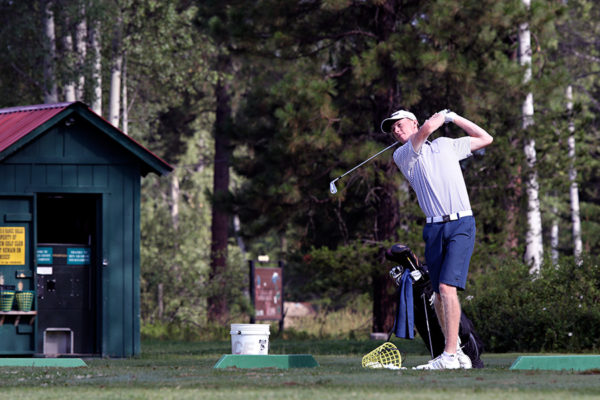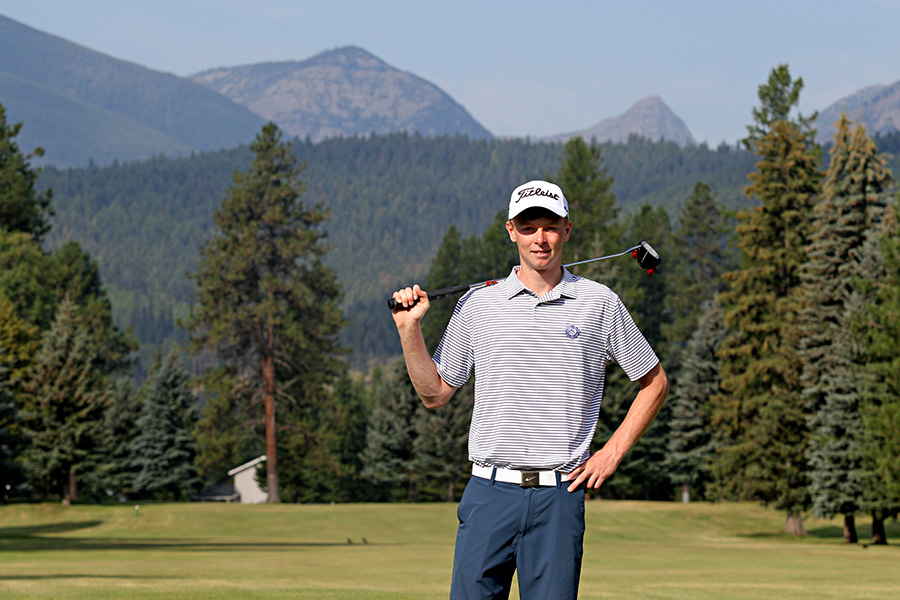The competition had been fierce most of the day under the watchful eye of Cindy Ostrem-Johnston.
Inside Libby High School, the health and physical education teacher had brought her son to school that day, and he had been entertaining himself by challenging Ostrem-Johnston’s teenage students at the ping-pong table, dispatching eager challengers one-by-one. He made it to what would be the day’s championship match, at which time his mother made a proclamation.
“If my student lost to him he had to sweep the floor for a week,” she remembered.
Her son, Ryggs, is a ferocious competitor, betraying a humble, soft-spoken veneer. It is a competitiveness he inherited from his parents, both college athletes, and his doting grandparents, who have nurtured his incredible drive since before he even learned to walk.
But Ryggs was also a little out of his element that day at school. The opponents he had been vanquishing throughout the day were not his friends, not even his classmates, and each matchup was, frankly, a completely unfair fight.
So when the final match began, he did the thing he thought was right, even if it meant his insatiable hunger to win would go unfed. Ryggs Johnston lost on purpose.
“He liked the kid,” Ostrem-Johnston explained. “He let him win so he didn’t have to sweep the floors for a week.”
Ryggs, at the time, was in kindergarten.

Late last month, 18-year-old Ryggs Johnston was in a playoff at a U.S. Amateur Qualifying Tournament at the Ranch Club in Missoula. He was staring down Patrick Murphy, a rising senior golfer at UCLA, who had come back to tie Johnston at 5-under-par after 36 holes. The two were battling for a single spot in the 118th U.S. Amateur Championship in Pebble Beach, California.
Johnston was just a few days removed from becoming one of the youngest golfers to ever win the Montana State Amateur, doing so in overwhelming, record-breaking fashion, but on this day in Missoula the collegian would get the best of him, prevailing on the third playoff hole and ending, Johnston thought, his summer season.
“I played average,” Johnston said a few days after the loss, still stinging from the narrow defeat.
Johnston isn’t used to setbacks, especially when he tees it up on a golf course in his home state. Johnston has won three state championships at Libby High School — setting the Class A and B tournament records in the process — and is an overwhelming favorite to win a fourth this fall. He’s been making headlines here since he was winning junior tournaments in the Flathead Valley as a 10-year-old.
But when he first started venturing out of Montana and into the uber-competitive world of elite amateur golf, Johnston went from threatening to win just about every time he hit the course to finishing in the middle of the pack against the best 10-, 11- and 12-year-olds in the world. At the time, he didn’t handle failure well.
“We went through some painful times when he was younger,” Ostrem-Johnston said. “He would come back to the hotel and just be devastated.”
His disappointment would show up on the course, too. The quiet kid would throw mini-fits, slamming his clubs and losing his composure. He was just a child, sure, but out on the course his mom worried others were getting the wrong impression of her son.
“Some people can appreciate the competitiveness and that drive to be the best he can be, and other people are like, ‘He’s a little jerk,’” she said. “It’s just different perspectives, but we didn’t want him to bring any negative attention to himself.”
What others told her, though, was to be careful not to smother that competitive flame.
“I’m not going to say we haven’t had a few bumps in the road and there were times where (his emotion) got in the way,” Dann Rohrer, Libby High School’s longtime golf coach, said. “But the last thing I wanted to do is kill his competitiveness and his spirit. You want him to never want to get beat — that’s the commitment you have to have.”
“He wants to kick your butt,” Floyd Horgen, Johnston’s swing coach for the last four-plus years, said. “The best players on the planet are extremely competitive; you have to be. Golf doesn’t treat you wonderfully all the time … Golfers are the most arrogant athletes on the planet, but they’re not obnoxious because they’ve already learned that something bad is around the corner that you have to deal with.”
As he’s matured from child to teenager to young man, Johnston has also channeled that competitive energy into making himself an even better golfer.
“I don’t mind him being a little bit angry because he’ll put more hours in,” Rohrer said.
“We’re all competitive, too, but he’s self-motivated, self-driven,” Ostrem-Johnston said. “We never forced him to do anything, it was always ‘Ryggs can we go home yet? We’re tired, we’re hungry.’”
Johnston has spent his entire life in Libby, living on his parents’ property just down the road from his grandparents, Vicki and Norm Ostrem, and has spent most of that time playing a sport of some kind.
“As soon as he could sit up we started tossing a ball to him,” Ostrem-Johnston said. “We tried to expose him to other things — trampolines, trucks — he didn’t want anything to do with anything that didn’t involve a ball.”
And everyone has a story about Johnston’s uncommon athletic ability and obsessive commitment to sports. He and his grandmother would play catch, Ostrem-Johnston said, and Ryggs would set a goal of completing 50 straight catches. If one of them dropped number 49, he would start over.
Then there was the basketball court, where Johnston was seemingly born with an impossibly pure shooting stroke. He competed twice in the Elks National Hoop Shoot, finishing second in the country as an 11-year-old and third at age 13. Then there’s the urban legend, one of those rumors that’s plausible enough that no one’s going to deny it, that he once made 114 free throws in a row. He’s an all-state basketball player for the Loggers and he’s coming off a season in which he made 11 3-pointers in a game against Missoula Loyola.
“He has a hand-eye coordination that I’ve never seen,” Rohrer said. “I’ve coached for over 40 years and you see a lot of athletes — we’ve had some great athletes — but there’s just something unique about him.”
Horgen, who coached golf at Centenary College in Shreveport, Louisiana where he mentored 14-time PGA Tour winner Hal Sutton, and has been working with elite golfers for 50 years, agrees.
“(Johnston)’s the best package I’ve ever seen,” Horgen said. “Talent, desire, intelligence; he’s the whole deal.”

Johnston has played countless rounds at Cabinet View Golf Club, his hometown course, and on a warm, sunny morning a few days after that U.S. Amateur qualifier in Missoula, he has his TaylorMade M3 driver in his hands, lining up his first drive of the day.
Effortlessly, the club glides behind him before sweeping back through the ball at his feet. It smacks off the club’s face and begins its lengthy flight, screaming past the 250-yard sign and over a hill probably 50 yards beyond that. The hill is supposed to mark the far boundary of the driving range. The range cannot contain Ryggs Johnston.
Johnston first came to Cabinet View as a 2-year-old, accompanied by his grandparents who set him up on the putting green and let him go to work. Predictably, he didn’t want to stop.
“I’ve never seen a kid that age just putt for hours,” Rohrer said. “I can still remember him crying when his grandma would say ‘we have to go,’ and he’s no different to this day.”
When he wasn’t on the putting green as a youngster, he was in his family’s driveway, setting up a tee next to a lawn chair while for hours at a time his relatives would work in shifts, pulling balls out of a five-gallon bucket and dropping them onto the tee for the younger golfer to whack into the lawn. When he started hitting balls into the neighbor’s yard, his parents bought him a simulator that he now wears out in the winter months.
“I think people thought we were forcing him to practice all the time,” Ostrem-Johnston said. “But that’s never been the case.”
Through all the rounds, all the travel and all the competition, however, Johnston has not lost his love for the game. He said he learned most of his early swing mechanics by watching golf on TV, and he watched his favorite golfer, Tiger Woods, flirt with a title a few weeks back at the British Open, in between his own tournaments. His training regimen consists mostly of golfing, working feverishly on every aspect of his game.
“You can overthink it sometimes and be like ‘oh, I need to work on all short game,’ and then you don’t hit it good off the tee,” Johnston said. “You’ve got to keep everything smooth.”
Johnston is incredibly accurate off the tee and has more strength than his slender build would suggest, but his short game stood out to Horgen the first time he saw the phenom playing at Riverside Country Club in Bozeman, where Horgen lives.
“When I first saw him he was as good around the green as anybody his age on the planet,” Horgen said.
Johnston’s next step as a golfer will take him to Arizona State University, where he will join one of the country’s best college teams in the fall of 2019. It’s a chance for Johnston to tee it up with and against other ultra-talented peers.
“That’s definitely part of it,” he said. “To challenge myself so I can get better.”
After that, only time will tell. Johnston’s humility doesn’t allow him to daydream in too grand of terms about his future, but with the chance to work in brand new practice facilities at ASU and work with renowned coaches, strength trainers, dieticians and more, the sky appears to be the limit.
Until he heads south, though, Johnston has a little more golf to play this summer. Days after falling short in the playoff at the U.S. Amateur qualifier, Ostrem-Johnston’s phone rang and a tournament official asked her if Ryggs was available to fill a spot vacated by another qualifier. She eagerly said yes.
It will be Johnston’s second time playing at the U.S. Amateur — he qualified as a 15-year-old in 2015 — and his first time playing at Pebble Beach Golf Links and Spyglass Hill Golf Course. The tournament runs Aug. 13-19. But it will also put a bit of a damper on his late-summer fishing plans, something he will dive fully into after the high school golf season ends in late September.
“You catch some big fish in October,” he said with a smile.
In the meantime, it’s back to the driving range and practice green for Johnston, who will go into the U.S. Amateur without facing much in the way of expectations, except for the ones he places on himself. He’ll be facing older, more experienced competition from states with better golfers, better facilities and better weather. But counting Johnston out in any competition is a mistake few people make more than once.
“It’s a real honor and a unique opportunity to have a fellow like this, a once-in-a-lifetime thing,” Rohrer said. “He’s the best player in the state, but he doesn’t act like it. That’s the cool thing about him.”
